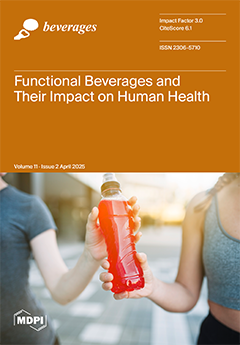To obtain fundamental information on the Tequila 100% agave
Cristalino commercial samples were characterized in their different classes. For this purpose, 12 samples were chosen, defined as: G1 (aged;
n = 3, or extra-aged;
n = 3) and G2 (aged-
Cristalino;
n
[...] Read more.
To obtain fundamental information on the Tequila 100% agave
Cristalino commercial samples were characterized in their different classes. For this purpose, 12 samples were chosen, defined as: G1 (aged;
n = 3, or extra-aged;
n = 3) and G2 (aged-
Cristalino;
n = 3 or extra-aged-
Cristalino;
n = 3). Analytical characterization was performed on these beverages, consisting of isotope ratio mass spectrometry, gas and liquid chromatography, UV-Vis spectroscopy, and color using digital image processing. The results corroborate that the chromatographic characterization (mg/100 mL A.A.)—higher alcohols (299.53 ± 46.56), methanol (212.02 ± 32.28), esters (26.02 ± 4.60), aldehydes (8.93 ± 4.61), and furfural (1.02 ± 0.56)—and isotopic characterization—δ
13C
VPDB = −13.02 ± 0.35 ‰ and δ
18O
VSMOW = 21.31 ± 1.33 ‰—do not present statistically significant differences (
p > 0.05) between groups. From these techniques, it was possible to reinforce that isotopic ratios can provide information about that the ethanol of these alcoholic beverages come from
Agave tequilana Weber blue variety and it is not affected in the filtration process. Based on the UV-Vis analysis, I
280 and I
365 were obtained, which were related to the presence of polyphenols and flavonoids—expressed as mg quercetin equivalents/L—only found in group 1. Due to the presence of flavonoids in aged beverages, the oxidation process results in the formation of an amber color, which can be measured by an RGB color model; therefore, the analysis shows that there is a statistically significant difference (
p < 0.05) between groups. It can be concluded that Tequila 100% agave
Cristalino is a Tequila 100% agave aged or extra-aged without color in which its chromatographic and isotopic profile is not affected.
Full article





